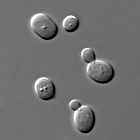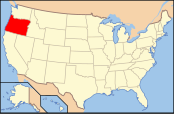Portal:Wine/Selected article
historical reference. . Either the page is no longer relevant or consensus on its purpose has become unclear. To revive discussion, seek broader input via a forum such as the village pump |
| Note: Article entries are now located at Portal:Wine/Selected articles, from where they are transcluded directly on the main portal page. |
Usage
The template for used to configure these sub-pages is located at {{Selected article}}.
- Add a new Selected article to the next available subpage.
- Update "max=" to new total for its {{Random portal component}} on the main page.
Selected article 1
Portal:Wine/Selected article/1
Yeasts are , although some yeasts can reach over 40 µm.The yeast species
Yeasts do not form a specific taxonomic or phylogenetic grouping. At present it is estimated that only 1% of all yeast species have been described. The term "yeast" is often taken as a synonym for S. cerevisiae, but the phylogenetic diversity of yeasts is shown by their placement in both divisions Ascomycota and Basidiomycota. The budding yeasts ("true yeasts") are classified in the order Saccharomycetales. (Full article...)
Selected article 2
Portal:Wine/Selected article/2
On the whole, biblical literature displays an ambivalence toward intoxicating drinks, considering them both a
Selected article 3
Portal:Wine/Selected article/3
Ethanol, also called ethyl alcohol, pure alcohol, grain alcohol, or drinking alcohol, is aEthanol is a straight-chain alcohol, and its
The fermentation of sugar into ethanol is one of the earliest organic reactions employed by humanity. The intoxicating effects of ethanol consumption have been known since ancient times. In modern times, ethanol intended for industrial use is also produced from by-products of petroleum refining. (Full article...)
Selected article 4
Portal:Wine/Selected article/4

Selected article 5
Portal:Wine/Selected article/5

How the Phylloxera aphid was introduced to Europe remains debated: American vines had been taken to Europe many times before, for reasons including experimentation and trials in grafting, without consideration of the possibility of the introduction of pestilence. While the Phylloxera was thought to have arrived sometime around 1858, it was first recorded in France in 1863, near the former province of Languedoc. It is argued by some that the introduction of such pests as phylloxera was only a problem after the invention of steamships, which allowed a faster journey across the ocean, and consequently allowed durable pests, such as the Phylloxera, to survive.
Eventually, following
Selected article 6
Portal:Wine/Selected article/6
A wine fault or defect is an unpleasant characteristic of a
Selected article 7
Selected article 8
Portal:Wine/Selected article/8
The state of Oregon in the United States has established an international reputation for its production of wine. Oregon has several different growing regions within the state's borders which are well-suited to the cultivation of grapes; additional regions straddle the border between Oregon and the states of Washington and Idaho. Wine making dates back to pioneer times in the 1840s, with commercial production beginning in the 1960s.With 303 wineries in Oregon, a tourism industry has developed around wine tasting. Much of the tourism focuses on the wineries and tasting rooms in and around the Yamhill Valley southwest of Portland. In 2004, it was estimated that wine tourism contributed USD $92 million to the state economy, excluding winery and tasting room sales. (Full article...)
Selected article 9
Portal:Wine/Selected article/9
The use of
Selected article 10
Portal:Wine/Selected article/10
Selected article 11
Portal:Wine/Selected article/11
The Champagne wine region (Located at the northern edges of the wine growing world, the history of the Champagne wine region has had a significant role in the development of this unique terroir. The area's close proximity to Paris promoted the regions economic success in its wine trade but also put the villages and vineyards in the path of marching armies on their way to the French capital. Despite the frequency of these military conflict, the regions developed a reputation for quality wine production in the early Middle Ages and was able to continue that reputation as the region's producers began making sparkling wine with the advent of the great Champagne houses in the 17th & 18th century.
The principal grapes grown in the region include
Selected article 12
Portal:Wine/Selected article/12
Commandaria (or Commanderia; Greek: Κουμανδαρία) is an amber-coloured dessert wine made in the Commandaria region of Cyprus on the foothills of the Troodos mountains. It has the distinction of being the world's oldest named wine still in production.The wine has a rich history, said to date back to the time of the ancient Greeks, where it was a popular drink at festivals celebrating the goddess Aphrodite. A dried grape wine from Cyprus was first known to be described in 800 BC by the Greek poet Hesiod and was known as the Cypriot Manna. (Full article...)
Selected article 13
Portal:Wine/Selected article/13
Resveratrol is aKonrad T. Howitz and Robert Zipkin of BIOMOL International discovered that resveratrol increases the activity of an
The four stilbenoids cis- and trans-resveratrol, and cis- and trans-piceid are similar and related, and sometimes analyzed together as a group. (Full article...)
Selected article 14
Portal:Wine/Selected article/14
The Australian wine industry is the fourth largest exporter in the world, exporting over 400,000,000 litres a year to a large international export market that includes "old world" wine-producing countries such as France, Italy and Spain. There is also a significant domestic market for Australian wines, with Australians consuming over 400,000,000 litres of wine per year. The wine industry is a significant contributor to the Australian economy through production, employment, export and tourism. (Full article...)
Selected article 15
Portal:Wine/Selected article/15

Following a wine renaissance in the mid-20th century, Californian wine entered the international stage at the 1976 Judgment of Paris wine competition when Californian wines beat out French wines in both red and white wine categories. Today there are more than 1,200 wineries in the state, ranging from small boutique wineries to large corporations like E & J Gallo Winery with distribution across the globe. (Full article...)
Selected article 16
Wine is a popular drink in Italy.
Most wine-making in Italy is done in modern wineries. However, villagers who make wine for their own use sometimes still tread the grapes with their bare feet, until the juice is squeezed out. They believe this ancient method still makes the best wine. (Full article...)










